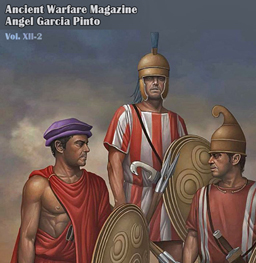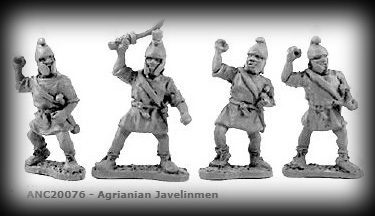|
Military
miniatures, ancient history, Macedonians and Successors,
Alexander the Great battles campaigns scenarios for
Warhammer Ancient Battles
|
Return
to AncientBattles.com
updated
09/21/2020
Ancient Miniatures and Historical Gaming
Agrianian
peltasts-
Alexander's elite killer commandos

Aornus (326 BC), by Giuseppe Rava
"After [Alexander] had taken a number
of other cities by storm and had slaughtered their defenders, he
came to the "rock" called Aornus.
Here the surviving natives had taken refuge because of its great
strength. It is said that Heracles of old thought to
lay siege to this "rock" but refrained because of the occurrence of
certain sharp earthquake shocks and other divine signs, and this
made Alexander
even more eager to capture the stronghold when he heard it, and so
to rival the god's reputation."
Diodorus Siculus 17.85
"But
when those who had been posted upon the mountain did not descend, a
charge was made by a few of the Agrianians and archers at
Alexander's order,
by which they were easily put to the rout from the foot of the
mountain." - Arrian
"The
Agrianians were commanded by a Macedonian, Attalus. They were
perhaps the most hard-worked corps in the whole army,
winning no fewer than twenty-seven separate mentions by name in
Arrian's narrative." - Griffith

 Agrianians scale the Sogdian Rock
Agrianians scale the Sogdian Rock
Miłek Jakubiec - ArtStation
https://www.artstation.com/milek
https://www.artstation.com/artwork/eADGD
|
Agrianians- nothing gets in their
way!
The
Agrianian tribesmen were related to the Paeonians
who had a close allied relationship with Macedonia. The
Paeonians are noted for their hard hitting light cavalry.
Their neighbors the Agrianians were foot skirmishers and
mountain men, noted for their ferocity in hand to hand combat,
as well as their javelin throwing. In Alexander's campaigns
they were able to tackle any terrain obstacle in their way.
1000 picked Agrianians were
attached to the hypaspists and they were the elite light
infantry in Alexander's army. They were the first foreign
contingent to be incorporated into, and accepted by the army.
Although known for their javelin skills, some were armed with
slings. The slingers and javelin men seemed to operate
together at a number of actions, most notably at the battle of
Issus where a detachment of Agrianes with some cavalry
squadrons in support drove back thousands of Persian
threatening Alexander' right flank at the start of the action.
Agrianians were constantly in
action, involved in every skirmish, commando raids, and battle
in Alexander's long campaigns.
One of their most famous actions was the scaling by night of
the Sogdian Rock. Three hundred volunteers raced up the cliffs
to appear the enemy defenses the next morning.
After the Indian campaign they seem to gone home, but
Successor armies continued to hire them as mercenaries, and
many settled in the conquered lands.
The style of dress of these
fellows is difficult to pin down. Duncan Head in AMPW
describes them as wearing Paeonian tunics that are depicted as
quilted on a surviving coin. The Sekunda Osprey Alexander
books have a painting of an Agrianian but that depiction is
rather odd as it shows neither javelins, nor any Thracian or
Paeonian gear at all, and a purple tunic.
The Agrianians were
sandwiched in between Thracians, Illyrians, Triballians,
Macedonians, Getae, and Celts, their dress could be a
conglomeration of these people's styles. Is this
illustration they are wearing trousers and half trousers to
help withstand the mountain cold of the Hindu Kush.
|


"At
Gaugamela it fell to their lot to face the charge of the scythed
chariots and prevent their interfering
with the Companion cavalry's entry into battle, a task they
performed faithfully and well." - Griffith
"The Agrianians and archers
together went through some very hard fighting, the latter having no
fewer than four commanders killed over them." - Griffith
Agrianians/Illyrians) in 28mm by Relic
Miniatures, and Wargames Foundry officer on the right.
Agrianian Commandos attack:
"At
the approach of night, leading with him the shield-bearing guards,
the Agrianians, the archers, and the brigades of Perdiccas and
Coenus,
after having given orders for the rest of the army to follow. As soon as he saw a favorable
opportunity for the attack, without waiting for all to be present,
he dispatched the archers and Agrianians against the foe.
These, being arranged in phalanx, fell unawares with the most
furious charge upon their flank, where they were likely to come
into conflict
with their weakest point, and slew some of them still in their
beds, others being easily caught in their flight. Accordingly,
many were there captured and killed,
as were many also in the disorderly and panic-stricken retreat
which ensued. Not a few, moreover, were taken prisoners.
Alexander kept up the pursuit as far as the Taulantian mountains;
and as many of them as escaped, preserved their lives by
throwing away their arms. Cleitus first fled for refuge into the
city, which, however, he set on fire,
and withdrew to Glaucias, in the land of the Taulantians." -
Arrian

This group
is odd because the chunkiest figure is the Old Glory trumpeter. These
show how using
many different kits and ranges allows maximum variations. Here the one
with their tunics pulled down
look nifty next to the others.
REFERENCES
Lately there are many more illustrations
dealing with Agrianians and their
neighboring Paeonians, than previously available.


"They
were favorite troops of Alexander himself, who occasionally
singled them out for special favor along with the
Hypaspistae and the so-called "Royal squadron" of the Companion
cavalry." - Griffith
Some close
ups. I just guessed with the Ram symbol because I saw a Paeonian
regional coin with that symbol on it. These are showing
helmet variations. A Macedonian style (left), and Illyrian styles
(middle, right).
This view is
nice scale line up of these miniatures. Foundry are the most chunky
styled of these, with some having very bulbous heads.
The Wargames Factory is an old plastic figure (Numidian) with a head
swap. The plastic Victrix figures are from their un-armored hoplite and
peltast sets.
The back view
as they move up into contact. This reveals my experiments with the
striping and colors.
Home made shield transfers:
Theses new shields have home made designs
based on the Ancient Warfare article above, and other regional designs.

Shield references:
Older
models in my 25-28mm collection:
Essex
25mm 1990's figures with Old Glory mixed in.

I
gave them "elite" purple shields

Old
Agrianians upgraded with newer faux embossed painted shields:

More to come... watch this space. Thanks
to Marcia for the very fine photos.
Miniatures on this page:
Relic
Miniatures Wargames Foundry
Old Glory
Newline Designs
Other Agrianian miniatures, A&A:
Xyston 15mm:

Old Agrianians page with low res photos:









 Agrianians scale the Sogdian Rock
Agrianians scale the Sogdian Rock


















